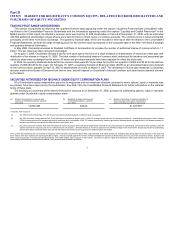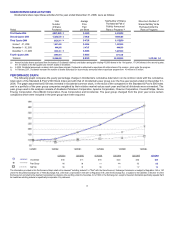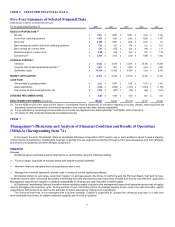Occidental Petroleum 2006 Annual Report Download - page 19
Download and view the complete annual report
Please find page 19 of the 2006 Occidental Petroleum annual report below. You can navigate through the pages in the report by either clicking on the pages listed below, or by using the keyword search tool below to find specific information within the annual report.
In May 2006, Ecuador terminated Occidental's contract for the operation of Block 15, which comprised all of its oil-producing operations in the
country, and seized Occidental's Block 15 assets. The process resulting in this action began shortly after Occidental prevailed, by unanimous
decision of an international arbitration panel subsequently upheld by a London court, in a legal dispute over tax refunds that Ecuador wrongfully
withheld. Occidental immediately filed an arbitration claim against Ecuador, seeking redress for illegal confiscation of the Block 15 operations with
the International Centre for Settlement of Investment Disputes in Washington, D.C., invoking the protections of the U.S. - Ecuador Bilateral
Investment Treaty. As a result of the seizure, Occidental classified its Block 15 operations as discontinued operations. In 2006, Occidental recorded
a net after-tax charge of $296 million in discontinued operations. This amount consists of after-tax charges for the write-off of the investment in
Block 15 in Ecuador, as well as ship-or-pay obligations entered into with respect to the Oleoducto de Crudos Pesados, Ltd. (OCP) pipeline in
Ecuador to ship oil produced in Block 15, partially offset by $109 million after-tax income from operations for the first five months of 2006.
Occidental’s Block 15 assets and liabilities are classified as assets and liabilities of discontinued operations on the consolidated balance sheets on
a retrospective basis.
In addition, Occidental has a 14-percent interest in the OCP oil export pipeline. See also "Off-Balance-Sheet Arrangements — Ecuador" for
further information about the OCP pipeline.
Production-Sharing Contracts
Occidental conducts its operations in Qatar, Oman and Yemen under PSCs and, under such contracts, receives a share of production to
recover its costs and an additional share for profit. In addition, Occidental's share of production from THUMS and Tidelands are subject to
contractual arrangements similar to a PSC. Occidental’s share of production from these contracts decreases when oil prices rise and increases
when oil prices decline. Overall, Occidental’s net economic benefit from these contracts is greater at higher oil prices.
Proved Reserves - Evaluation and Review Process
A senior corporate officer of Occidental is responsible for the internal audit and review of its oil and gas reserves data. In addition, a Corporate
Reserves Review Committee (Reserves Committee) has been established, consisting of senior corporate officers, to monitor and review
Occidental's oil and gas reserves. The Reserves Committee reports to the Audit Committee of Occidental's Board of Directors periodically
throughout the year. Occidental has retained Ryder Scott Company, L.P. (Ryder Scott), independent petroleum engineering consultants, to
review its annual oil and gas reserve estimation processes since 2004.
Again in 2006, Ryder Scott has compared Occidental’s methods and procedures for estimating oil and gas reserves to generally accepted
industry standards and has reviewed certain data, methods and procedures used in estimating reserves volumes, the economic evaluations and
reserves classifications. Ryder Scott reviewed the specific application of such methods and procedures for a selection of oil and gas fields
considered to be a valid representation of Occidental’s total reserves portfolio. In 2006, Ryder Scott reviewed 10.5 percent of Occidental’s oil and
gas reserves. Since being engaged in 2004, Ryder Scott has reviewed Occidental’s reserve estimation methods and procedures for approximately
49 percent of Occidental’s oil and gas reserves.
Based on this review, including the data, technical processes and interpretations presented by Occidental, Ryder Scott has concluded that the
methodologies used by Occidental in preparing the relevant estimates generally comply with current Securities and Exchange Commission (SEC)
standards. Ryder Scott has not been engaged to render an opinion as to the reserves volumes reported by Occidental.
Proved Reserve Additions
Occidental consolidated subsidiaries had proved reserves at year-end 2006 of 2,869 million BOE, as compared with the year-end 2005 amount
of 2,566 million BOE. Additionally, Occidental’s investments in other interests had proved reserves of 30 million and 45 million BOE at year-end
2006 and 2005, respectively. The increase in the consolidated subsidiaries’ reserves from all sources was 518 million BOE, of which 289 million
BOE were from proved developed reserves and 229 million BOE were from proved undeveloped reserves.
Proved developed reserves represent approximately 78 percent of Occidental’s total proved reserves at year-end 2006 compared to 74 percent
at year-end 2005.
Proved reserves consist of 78 percent crude oil and condensate and 22 percent natural gas.
In 2006, Occidental added net reserves of 17 million BOE through revisions of previous estimates, primarily in Libya, the Dolphin Project and
Argentina, partially offset by negative revisions in the United States reflecting a reduction in gas prices. Oil price changes would affect proved
reserves recorded by Occidental. For example, if oil prices increased by $5 per barrel, less oil volume is required to recover costs, and PSCs would
reduce Occidental's share of proved reserves by approximately 9 million BOE. Conversely, if oil prices dropped by $5 per barrel, Occidental's
share of proved reserves would increase by a similar amount. Oil price changes would also tend to affect the economic lives of proved reserves
from other contracts, in a manner partially offsetting the PSC reserve volume changes. Apart from the effects of product prices, Occidental's
approach to interpreting technical data regarding oil and gas reserves makes it more likely future reserve revisions will be positive rather than
negative.
15
























